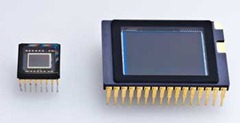When I first started dabbling in photography, I did my usual reading-up on the technical aspects of things – shutter speeds, f-stops, circles of confusion, depth of field, etc. And for a long time, I thought I knew what I was doing.
But recently I realized something that, in retrospect, I should have known all along – that not all f-stops are created equal. Or, to put it another way, f/2.8 on my camera might not be the same as f/2.8 on your camera.
The key fact was that the f-stop is not an absolute size – it’s a ratio.
This realization came about as I was trying to learn to do some creative depth of field related stuff with my Canon PowerShot S3 IS (as a follow-up to my previous experiments with depth of field) and I just couldn’t quite get that nice shallow depth of field I wanted. Then I was reading a new photography book I picked up recently called Understanding Exposure and I suddenly realized what I had been missing.
The basic principle is this – with point & shoot cameras (or any camera with a small sensor), the image being focused by the lens is being projected onto a very small square. In order to get the light to focus on this small square, your aperture (the size of the opening in the lens, which is what the f-number represents) has to be pretty small, otherwise the whole thing would be out of focus.
Throw in some other limitations (like the smaller size of lenses overall in point & shoot cameras, and the smaller distances between the lens elements and the image sensor) and basically in these sorts of cameras you are always going to have a physically small aperture – even if the f-number suggests otherwise. This is because the f-number is the ratio between the physical size of the lens opening and the focal length of the lens itself.
Because of this ratio nonsense, it means that you can have two cameras set to the same f-stop even though they have radically different physical sizes. The only thing that matters is the relative ratio between the lens opening and the focal length. Size is irrelevant.
However, size most definitely IS relevant when it comes to determining depth of field (or more technically, determining the circle of confusion). Because of their overall smaller sizes, point & shoot cameras come closer to being theoretically perfect pinhole cameras (which have theoretically infinite depth of field – or put another way, they have no blur because they focus everything perfectly). Larger cameras with larger sensors (and having both of these things is very important) can generate a smaller depth of field, which is why photos from such cameras (e.g., DSLRs) can achieve that amazing background blur that is often used to make interesting photos.
 To put this in concrete terms, when my camera is set to f/2.8, it is focusing the image on a very small sensor (see the picture comparison of a point & shoot sized sensor to a DSLR sized sensor on the right). So even though the ratio of my camera’s aperture gives us f/2.8, the actual light rays coming in are focused very sharply in that very small space.
To put this in concrete terms, when my camera is set to f/2.8, it is focusing the image on a very small sensor (see the picture comparison of a point & shoot sized sensor to a DSLR sized sensor on the right). So even though the ratio of my camera’s aperture gives us f/2.8, the actual light rays coming in are focused very sharply in that very small space.
Conversely, with a DSLR using a lens set to f/2.8, the image is focused on a much larger sensor. Because of the larger size of the lens and the sensor, the light rays can be “blurred” out a bit more – the circle of confusion is bigger – and thus you get that nice shallow depth of field effect.
It’s this critical fact which explains why it’s so hard to achieve this shallow depth of field effect on smaller sensor cameras (like point & shoot cameras – and that includes both compact cameras and even the physically larger “super-zoom” cameras like mine).
The next time you have your camera out, turn it around and look into the lens and see if you can see the aperture – the actual opening. If you can fiddle with the aperture controls while you’re looking you can see it move, if that helps you identify it. If you have any sort of point & shoot camera, you’ll see that it is actually very, very small – even if you’ve set it to a “large” aperture (small f-number).
Of course, the other side of this coin is that point & shoot cameras have an amazingly deep depth of field – one that most DSLRs can only dream of. Still, in my experience at least it’s better to err on the shallower side, at least for the types of photos I like to take.
People who are more knowledgeable about photography might be saying “well, duh” at this point – but it really took me a long time before I understood all of this, and I have to imagine that there are lots of other casual, amateur photographers like me out there who maybe have been wondering the same thing. But now, hopefully, we all have a better understanding of how lens & sensor size affect depth of field, even though the f-stop number itself is the same.